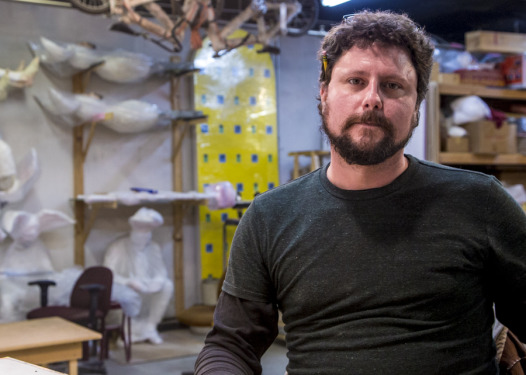
Artist Alex Podesta with his whimsical figures in his Art Egg studio (Photo: Hanna Rasanen)
Alex Podesta is known about town as the bunny-man artist.
He’s the one who created the quintet of whimsical men/bunnies, their hands wrapped securely around the stone parapet, who peer down at passers-by from the rooftop of a building on O.C. Haley Boulevard. He also created the pair of rabbit/humans who sprawl on their stomachs in front of the plate glass windows in the lobby of the Saratoga Building on Loyola Avenue. And, more recently, the two who bobbed up and down in the choppy waves of the Grand River in Michigan.
But there’s a lot more to Podesta – and his odd and endearing creatures – than surface humor. For one thing, they all are self-portraits – not only figuratively, but also literally, their visages having been sculpted from a plaster mask of Podesta’s own features. And for another, they offer a glimpse into the mind of an artist who is both humorous and whimsical, serious and studious, and always entertaining.
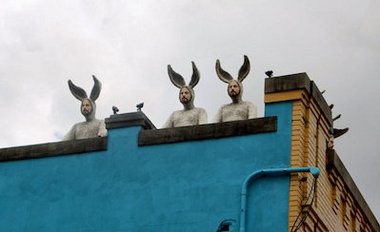
Three of Alex Podesta’s ‘bunny men’ gaze down on Oretha Castle Haley Boulevard from their rooftop perch. (Photo: Linda Friedman)
Born in North Carolina and raised in southeast Virginia, Podesta says he always thought of himself as a Southerner – until he moved to New Orleans. “Now my ties here are so deep now that you’d have to force me to leave,” he says with a smile.
He’s from a long line of artists – an art director grandfather worked with Louis Bunuel, an artist grandmother with Diego Rivera – which taught him mostly, he says, that making a living creatively is a struggle.
But by the time he was 12, it was pretty clear that he couldn’t sidestep the family fate. A clever charcoal portrait of Mark Twain done in elementary school hangs in his present-day studio, and, with his bent for woodworking, “my Christmas gifts were tools, not toys.”
Early on, the love of three-dimensional crafting and artistic rendering steered him into sculpture. It was a different creative talent, however, that brought him to Louisiana.
“I’d been working as a line cook,” he says. “My mother had four sons before she had a girl, so she made sure we all knew how to cook. ”
A few years back, that led to a job at a jazz club in Baton Rouge, where he was hired to run the kitchen. When things didn’t work out, he headed the 70 miles south to New Orleans, and has been here ever since.
“At one time I actually intended to leave, but at the end of 2006, I met Arwen (now his wife), and that was that. She was here for her residency, but we sort of got entrenched here.”
These days, Podesta, with an undergraduate degree and MFA from the University of New Orleans, spends his days in a spacious studio at Art Egg, where shelves and cabinets are filled with the odd and mystical accouterments of a man who makes a living as a carpenter, while earning local renown as a sculptor. Stacks of unfinished wood, planers, joiners and table saws here; bags of Styrofoam, clusters of antlers, sculpted hands perched on a table there.
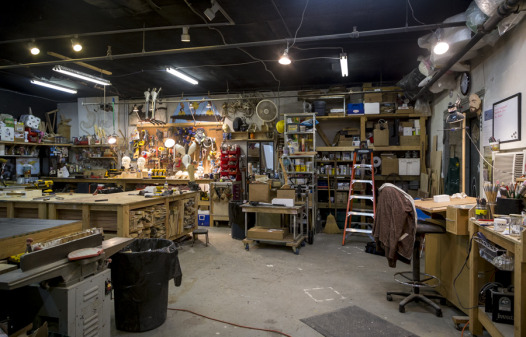
The tools of his trade in Podesta’s studio (Photo: Hanna Rasanen)
From a technical standpoint, Podesta says, both kinds of projects are planned meticulously before he picks up the first tool to begin work.
“My full-size figures are plotted out in advance,” he says. “I use a casting process to create the exposed features – the hands, the faces, the feet. They come together in a very specific way.”
These appendages are made of a plastic composite that is polished and painted, then screwed into armatures of steel and wood covered with Styrofoam that form the bodies of the figures.
The idea for the bunny men, Podesta says, started with playfully placed studies of specific body parts. “I’d have finger or toes poking out from under a wall inside the gallery.” A plaster-over-Styrofoam ottoman sitting on a shelf looks like the real thing – except for a copy of Podesta’s belly button that serves as the “button” on the sculpted top cushion.
“My works demand laughter,” he says.
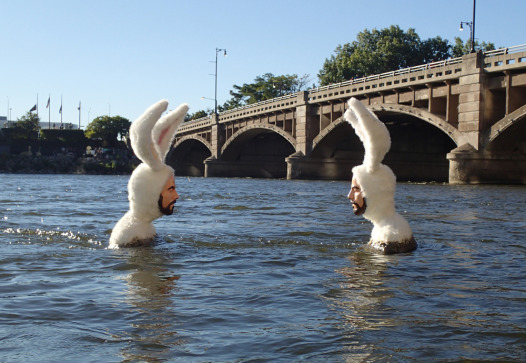
Grand River bunny men in Michigan, above, and costumed versions, below. (Photos: courtesy Alex Podesta)
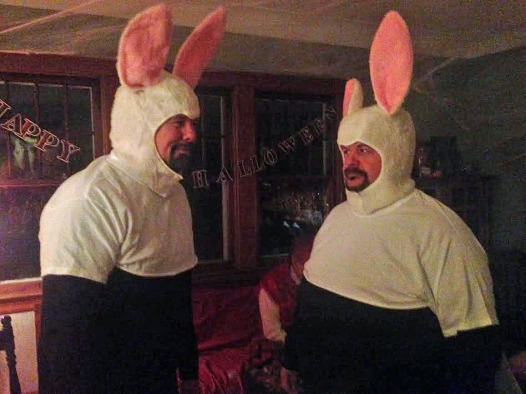
The first bunny man came from a desire to make his work more personal.
“I began digging into myself for more source material,” he explains. “I had this fun, crazy childhood growing up on an abandoned chicken farm, and I started thinking about that, and the freedom of those years. I had a one-piece, zip-up pair of pajamas with feet, and then I thought about cartoons and Bugs Bunny, and then I thought of super heros. There’s some Velveteen Rabbit in there, and the security of a stuffed bunny.”
He also had gotten a lot of faux fur to use in some way, and it turned out to be faux bunny fur.
All of that coalesced seven or eight years ago into the figures that look like grown men in bunny suits, although to Podesta, the bunny part is inherent in the figure, and not a costume. And while he likes the smile they bring to viewers – “there’s such a disconnect between a 6-foot-2 bearded man and a bunny” — he also infuses them with emotion and meaning. For one thing, he generally creates them in pairs, so that they are working together on something, or comforting each other in some way.
“The first pair I made has one figure standing behind the other, with a hand on his shoulder. They’re like double iterations of the same psyche or persona,” Podesta says. “I didn’t mean it to be such a long-lived series. But having those guys in the studio all the time, they started developing personalities. They seemed to be looking at me. So I decided I had to have more of them.”
The next pair were positioned supine on the floor, working together industriously on their own mini sculpture. “They’re fed up with their creator, so they are making their own Alex – cutting the face out of a magazine with my face on it, and putting this Alex mask on their own bunny.”
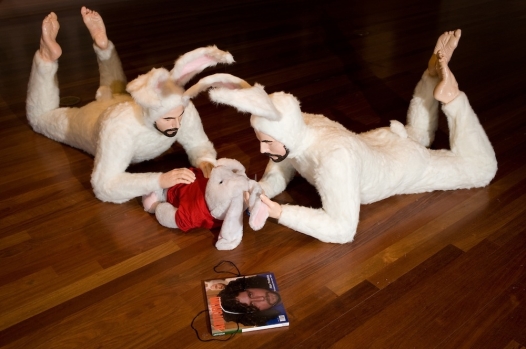
‘Self-Portrait as Bunnies (Hubris)’ (Photo: alexpodesta.com)
The O.C. Haley bunnies, whose title is City Watch, were part of a commission from the Arts Council of New Orleans and Joan Mitchell Foundation, originally slated to be placed in Bayou St. John. When permitting fell through, Podesta turned to the owners of the Falstaff Brewery on Tulane Avenue, then being converted to apartments, and the bunnies “lived” there from 2008 to 2010. From there they made their way to the current location on O.C. Haley.
“They’re an homage to Rodin’s Burghers of Calais,” Podesta says. “That work has six figures, but one is on his knees, begging for the city. I envisioned the city itself as the figure on its knees, with the five figures looking out at it – and also keeping an eye on the prison and the overpass across from them.”
That overpass could be seen from the Mid-City warehouse where Podesta spent 10 days after Hurricane Katrina. He watched prisoners being herded onto the concrete span, spanned by guards at either end. “It was insane,” he recalls.
Ninety percent of people who see the O.C. Haley figures, Podesta finds, “find it a quick surreal experience and then move on. The other 10 percent do that and then stop. And that’s fine — the figures are meant to be funny, but I also want the piece to reward a more detailed analysis of it.”
Podesta also has a series of life-sized little boys, their faces created by de-aging his own face. A pair of them, called The Hero, sit astride a giant rabbit on the top floor of Art Egg.
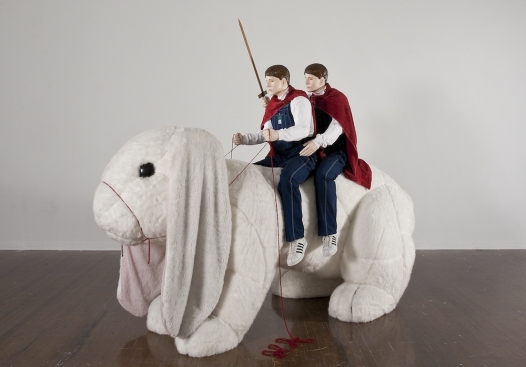
‘The Hero’ (Photo: alexpodesta.com)
His ongoing series of bike sculptures pair the bodies of two bikes, welded face to face, locked into eternal combat. While his bunny figures tend to work together, these pieces portray conflict. The use of antlers entwined with handlebars is, says the artist, a reference to Picasso, and matadors and bull rings. “The bike bars and antlers combine to become the bull.”
He does photographic pieces as well, richly textured color prints of elaborate miniature sets populated with small versions of his various figures.
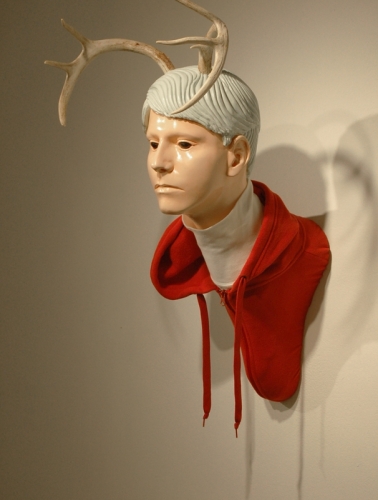
Untitled (A Study for Future Beasts) (Photo: alexpodesta.com)
Lately, Podesta has been working on a smaller scale. Antler-topped bunny heads mounted on wall plaques make trophies of personal mythologies. “It also allows me to work through different ideas without fully committing to full-sized sculptures.” The bunny men alone can take two or three hundred hours to complete.
One thing all of his figures have in common: “They are all Alex. It seems important to me to make them self-portraits, because they are tied to aspects of introspection that are universal.”
Now and then, at Mardi Gras, say, Podesta will run into people costumed as his bunny men. And he recently received a photo from two men in Michigan, dressed from chest up in white rabbit attire.
“They wrote that they’d gone to a Halloween party as Podesta bunnies,” the artist says with a laugh. “That’s when you know you’ve gotten somewhere.”
 NOLAbeings Multimedia artist Claire Bangser created NOLAbeings as a portrait-based story project that marries...
NOLAbeings Multimedia artist Claire Bangser created NOLAbeings as a portrait-based story project that marries...  Voodoo in New Orleans: Reviving history: New Orleans fortune telling This article takes a deep dive into the history of Voodoo in New Orleans, its hybridization with Catholicism, and its present-day place in the city's culture. The author visits fortune-tellers in the French Quarter, using their guidance as a tool for introspection rather than a deterministic predictor of the future. Through her experiences in New Orleans, the author feels a mystical connection to both the past and the future.
Voodoo in New Orleans: Reviving history: New Orleans fortune telling This article takes a deep dive into the history of Voodoo in New Orleans, its hybridization with Catholicism, and its present-day place in the city's culture. The author visits fortune-tellers in the French Quarter, using their guidance as a tool for introspection rather than a deterministic predictor of the future. Through her experiences in New Orleans, the author feels a mystical connection to both the past and the future. 